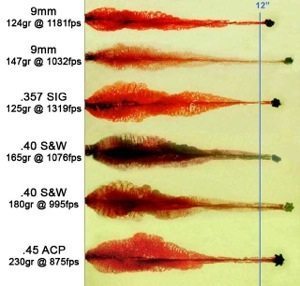This is an old revision of the document!
Caliber & Types of Bullets
Caliber
You've probably heard someone use the term “knock-down” or “stopping power” associated with a bullet's perceived ability to stop a threat. Unfortunately, there is no way to measure “knock-down/stopping power” because it is a “digital” concept with a multitude of variables. So the term becomes meaningless. However, we can measure the amount of energy transferred to a target AND we can see the type of wound channel a specific bullet is likely to produce in a ballistic gelatin (simulating a human body)… with no hard impediments that could deflect a bullet - such as bones.
 Following the aftermath of the 1986 “FBI Miami shootout”, the FBI “ Handgun Wounding Factors and Effectiveness” paper stated: “Penetration less than 12 inches is too little, and, in the words of two of the participants in the 1987 Wound Ballistics Workshop, “too little penetration will get you killed”. Given desirable and reliable penetration, the only way to increase bullet effectiveness is to increase the severity of the wound by increasing the size of hole made by the bullet. Any bullet which will not penetrate through vital organs from less than optimal angles is not acceptable. Of those that will penetrate, the edge is always with the bigger bullet.”
Following the aftermath of the 1986 “FBI Miami shootout”, the FBI “ Handgun Wounding Factors and Effectiveness” paper stated: “Penetration less than 12 inches is too little, and, in the words of two of the participants in the 1987 Wound Ballistics Workshop, “too little penetration will get you killed”. Given desirable and reliable penetration, the only way to increase bullet effectiveness is to increase the severity of the wound by increasing the size of hole made by the bullet. Any bullet which will not penetrate through vital organs from less than optimal angles is not acceptable. Of those that will penetrate, the edge is always with the bigger bullet.”
As we see in the chart to the right, all of the rounds tested exceeded 12“ penetration. And while a wound channel in ballistic gelatin may not tell the entire story, it does give us ideas as to what a specific bullet does. Ultimately, shot placement is the most important factor… and those who choose a smaller handgun have already made that compromise. Yet, we should never forget that a well placed .22 caliber bullet, whether by luck or skill, can be lethal.
<note>Most of the FBI agents involved in the 1986 “FBI Miami shootout” were armed with either .357 Magnum revolvers or .38 Special +P revolvers - which proved slow and difficult to re-load. The two agents who were killed were carrying Smith & Wesson Model 459, 9mm semi-automatic pistols. Although the suspects had been shot numerous times, they continued to fight on. One suspect was shot 12 times, and the other was shot 7 times before the fight ended.</note>
<note warning>The 1911 was designed to fire “ball” ammunition. Consequently, it tends to have difficulty chambering bullets with flat noses (e.g., many hollow point bullets, wadcutters). While Winchester does manufacture a hollow point bullet designed specifically for the 1911 (the WIN 1911), there are few hollow points that will reliably chamber into a 1911. So if you want a pistol that fires .45 ACP bullets with these other configurations - and don't mind compromising on the straight slide trigger - consider the HK45 Tactical, Glock 21, Glock 30, Glock 36 , Glock 41 and/or Sig Sauer P220 Legion.</note>

